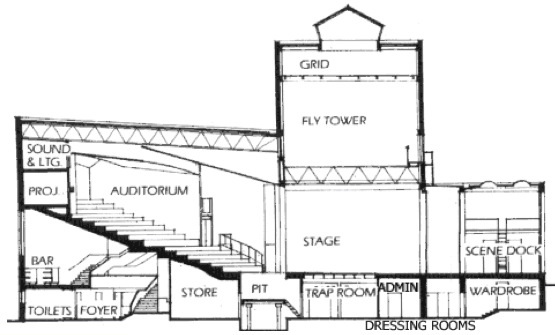Opened in 1967 on the University of Exeter campus. Originally 433 seats, now 464 following refurbishment.
Architect: Sir William Holford and Partners [also came up with 1955 plans for the University and later was architect for Queens Building & Devonshire House (1958), Northcote House & Senate Chamber (1960-1970)]
Theatre Consultant: Michael Warre (had previously worked on the 1963 Macowan theatre at LAMDA, which impressed the University management with its' flexibility)
Michael Warre had previously worked on the Billingham Forum Leisure complex.
Official website: www.exeternorthcott.co.uk
Technical Information & Dimensions: http://www.exeternorthcott.co.uk/technical-information

Northcott Theatre section
Equipment
1971 (from The Stage Guide)
Electrics: SP60 rear of auditorium, Dimmers: 60 (56 x 2kW & 4 x 5kW); 3 presets, 2 groups. Patching system - 114 way by relay. Circuits FOH 48 (slots and side walls); Flies 52; Stage dips 12. Socket type 15A BESA. Total capacity available: 600A on 3 phases. Special effects supply: 180A on 3 phases. No footlights. No follow spots. Sound: Console in rear of auditorium. Amplifier - 20 x 60W. Tape decks - 1 Revox 2 track and 1 Brenell mono. Turntables - 2 Goldring GL70 Stereo. Mic sockets - 2 Cannon 3 pin. Loudspeakers - 2 rear and end, 2 on pros. Spare sockets - 2 x 2 pin (Bulgin) on stage. See also Journal links at the bottom of this page:
- "Five Hundred or Fifteen Hundred", TABS, December 1967 - Vol.25 Issue 4
- "Exeter in the Round", TABS June 1969 - Vol.27 Issue 2 (page 37)
Exhibits from this venue in the Backstage Heritage Collection
- SP/40 Control Desk (1971)
Links to information about equipment at Northcott Theatre Exeter over the years
- SP Series (Strand)
- Threeset (Strand)
- 530 / 550 (Strand)
- Gemini (Strand)
- B77 Tape Recorder/Player (Revox)
Documents

Privates on Parade - Jonathan Goff (June 1980)
[LX Plan - click on the thumbnail]
From Maurice Marshal Collection

Utopia Ltd - Chris Coxhead (February 1981)
[LX Plan - click on the thumbnail]
From Maurice Marshal Collection

Summer Song - Maurice Marshal (March 1981)
[LX Plan - click on the thumbnail]
From Maurice Marshal Collection

Lear - Maurice Marshal (March 1981)
[LX Plan - click on the thumbnail]
From Maurice Marshal Collection

Dear Brutus - Graham Large (May 1981)
[LX Plan - click on the thumbnail]
From Maurice Marshal Collection

Dandy Dick - Jonathan Goff (July 1981)
[LX Plan - click on the thumbnail]
From Maurice Marshal Collection

The Dresser - Graham Large (August 1981)
[LX Plan - click on the thumbnail]
From Maurice Marshal Collection

Flarepath - Jonathan Goff (October 1981)
[LX Plan - click on the thumbnail]
From Maurice Marshal Collection

Favours - Graham Large (November 1981)
[LX Plan - click on the thumbnail]
From Maurice Marshal Collection

Rehearsal - Jonathan Goff (April 1982)
[LX Plan - click on the thumbnail]
From Maurice Marshal Collection

Absurd Person Singular - Maurice Marshal (September 1982)
[LX Plan - click on the thumbnail]
From Maurice Marshal Collection

The Offshore Island - Jonathan Goff (February 1983)
[LX Plan - click on the thumbnail]
From Maurice Marshal Collection

See How They Run - Maurice Marshal (April 1983)
[LX Plan - click on the thumbnail]
From Maurice Marshal Collection

Barefoot in the Park - Jonathan Goff (May 1983)
[LX Plan - click on the thumbnail]
From Maurice Marshal Collection

You Never Can Tell - Hugh Vanstone (May 1983)
[LX Plan - click on the thumbnail]
From Maurice Marshal Collection
![You Never Can Tell [section] - Hugh Vanstone You Never Can Tell [section] - Hugh Vanstone](/archive/docthumbs/2382.jpg)
You Never Can Tell [section] - Hugh Vanstone (May 1983)
[LX Plan - click on the thumbnail]
From Maurice Marshal Collection

Deathtrap - Jonathan Goff (June 1983)
[LX Plan - click on the thumbnail]
From Maurice Marshal Collection

Perchance to Dream - Hugh Vanstone (July 1983)
[LX Plan - click on the thumbnail]
From Maurice Marshal Collection

Cider with Rosie - Maurice Marshal (August 1983)
[LX Plan - click on the thumbnail]
From Maurice Marshal Collection

Two Planks And A Passion - Nick Chelton (November 1983)
[LX Plan - click on the thumbnail]
From Maurice Marshal Collection

Showboat - Michael Calf (December 1983)
[LX Plan - click on the thumbnail]
From Maurice Marshal Collection

Tutankhamun - Jonathan Goff (March 1984)
[LX Plan - click on the thumbnail]
From Maurice Marshal Collection

Lloyd George Knew My Father - Michael Matthews (March 1984)
[LX Plan - click on the thumbnail]
From Maurice Marshal Collection

The Arcadians - Nick Chelton (June 1984)
[LX Plan - click on the thumbnail]
From Maurice Marshal Collection

Ten Little Indians - Hugh Vanstone (August 1984)
[LX Plan - click on the thumbnail]
From Maurice Marshal Collection

The Ladys Not For Burning - Jonathan Goff (September 1984)
[LX Plan - click on the thumbnail]
From Maurice Marshal Collection

Katerina - Nick Chelton (October 1984)
[LX Plan - click on the thumbnail]
From Maurice Marshal Collection

Toad of Toad Hall - Jonathan Goff (December 1984)
[LX Plan - click on the thumbnail]
From Maurice Marshal Collection

Northanger Abbey - Jon Primrose (October 1996)
[LX Plan - click on the thumbnail]
From Maurice Marshal Collection

Far From The Madding Crowd - Jon Primrose (August 1997)
[LX Plan - click on the thumbnail]
From Maurice Marshal Collection








